The Impact of the Digital Economy on Enterprise Sustainable Development and Its Spatial-Temporal Evolution: An Empirical Analysis Based on Urban Panel Data in China
Abstract
1. Introduction
2. Literature Review and Research Hypothesis
2.1. The Relationship between Digital Economy and Enterprise Sustainable Development
2.2. Digital Economy, Regional Innovation and Entrepreneurship, and Sustainable Enterprise Development
3. Model Design
3.1. The Model
3.2. The Variables
3.3. Data Sources
4. Measurement and Analysis of Digital Economy and Enterprise Sustainable Development
4.1. The Measure Analysis of Digital Economy
4.1.1. Digital Economy Level Descriptive Characteristics
4.1.2. Spatial Evolution Characteristics of the Digital Economy
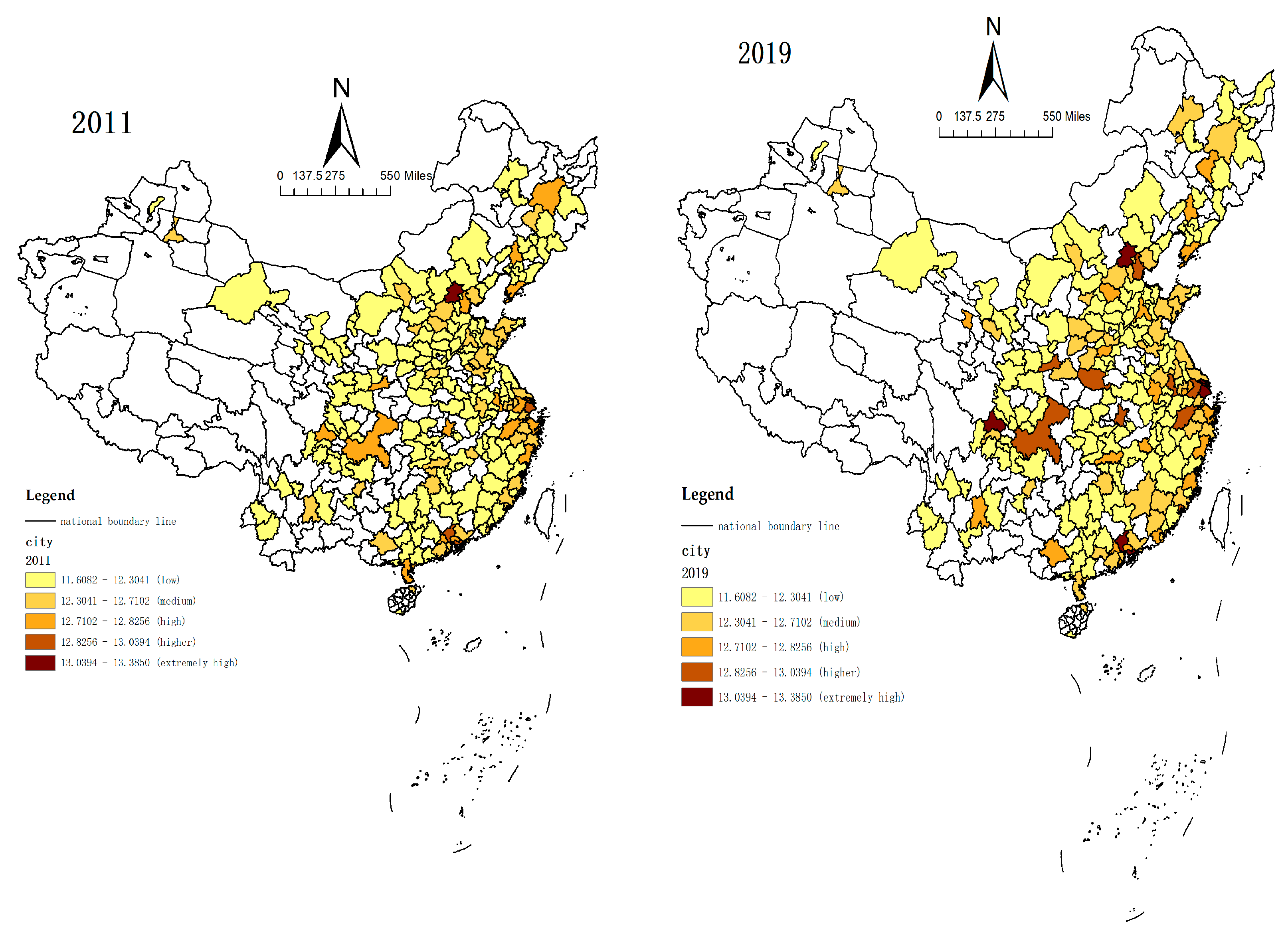

4.2. Spatial Evolution Characteristics of Enterprise Sustainable Development
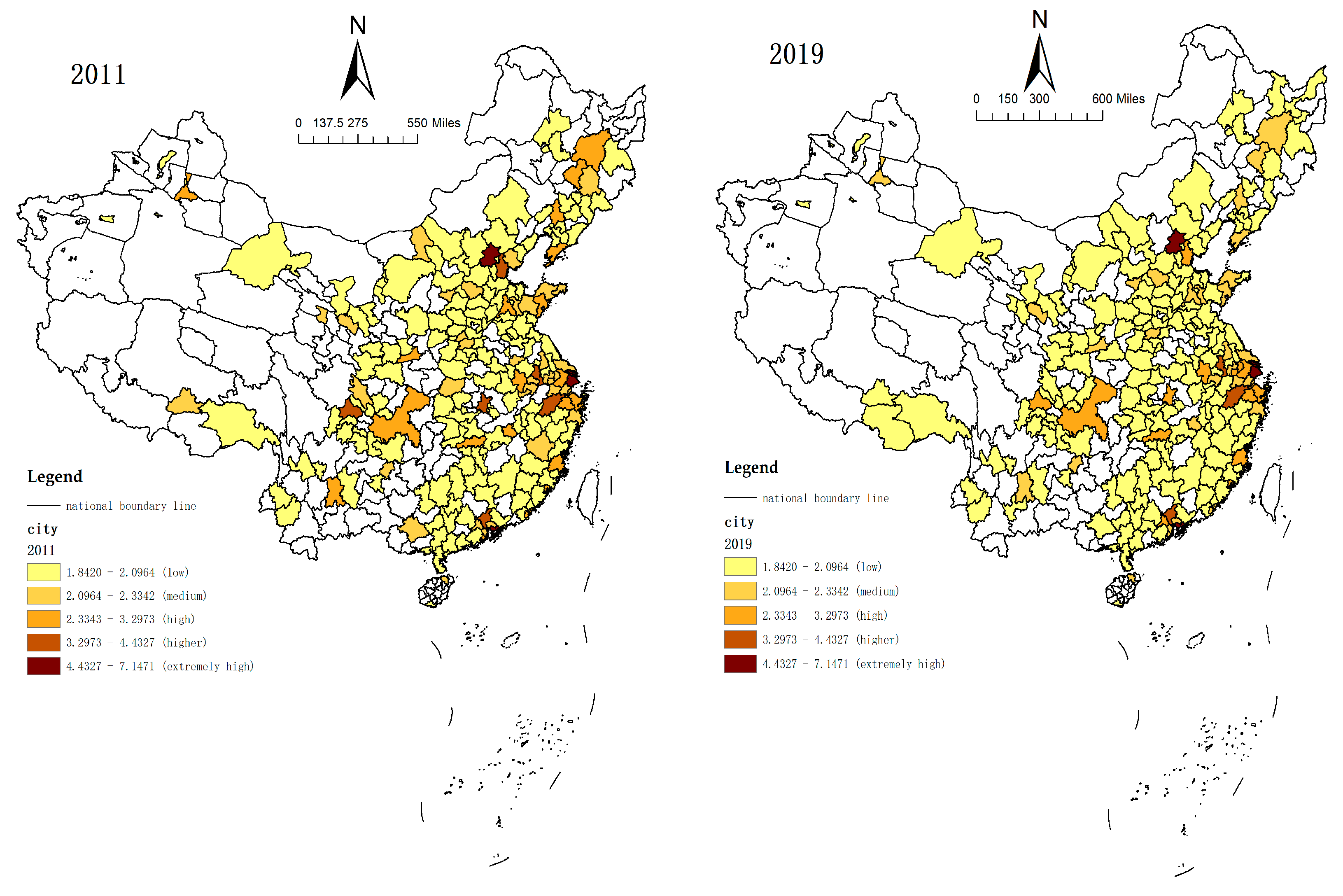
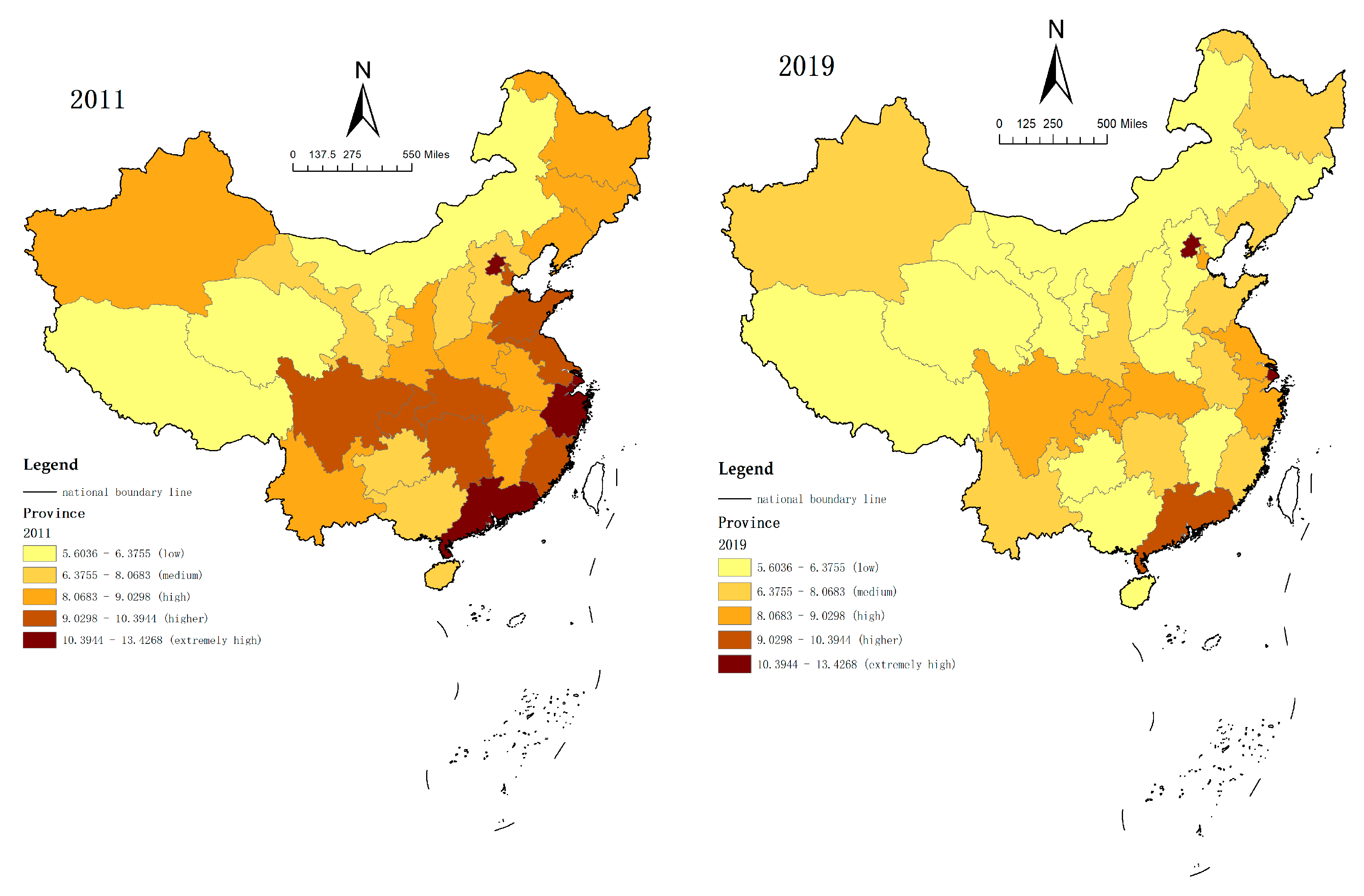
5. Empirical Test
5.1. Descriptive Statistics of Variables
5.2. Benchmark Regression and Robustness Testing
5.3. Endogenous Test
5.4. Spatial Heterogeneity Analysis
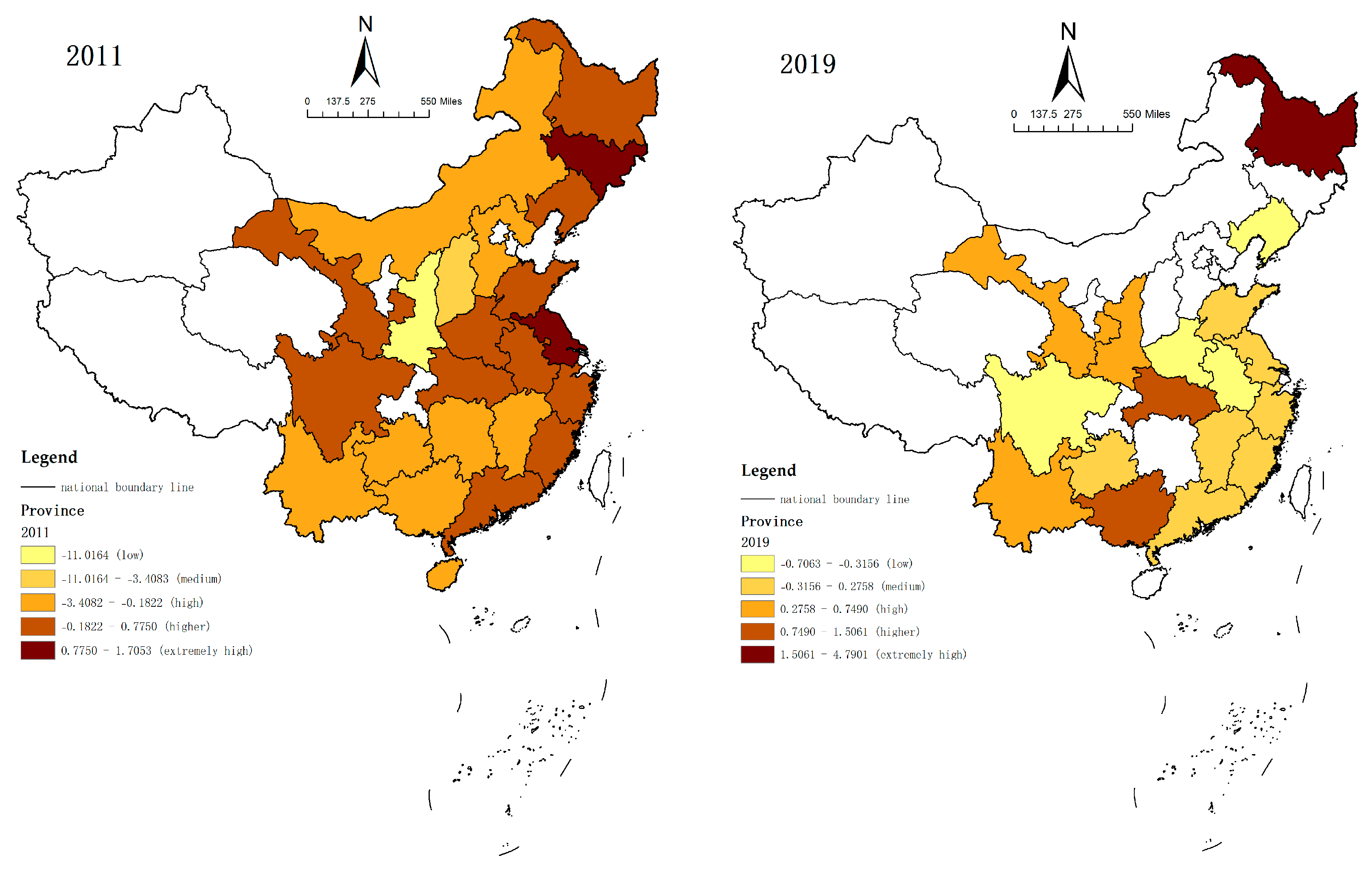
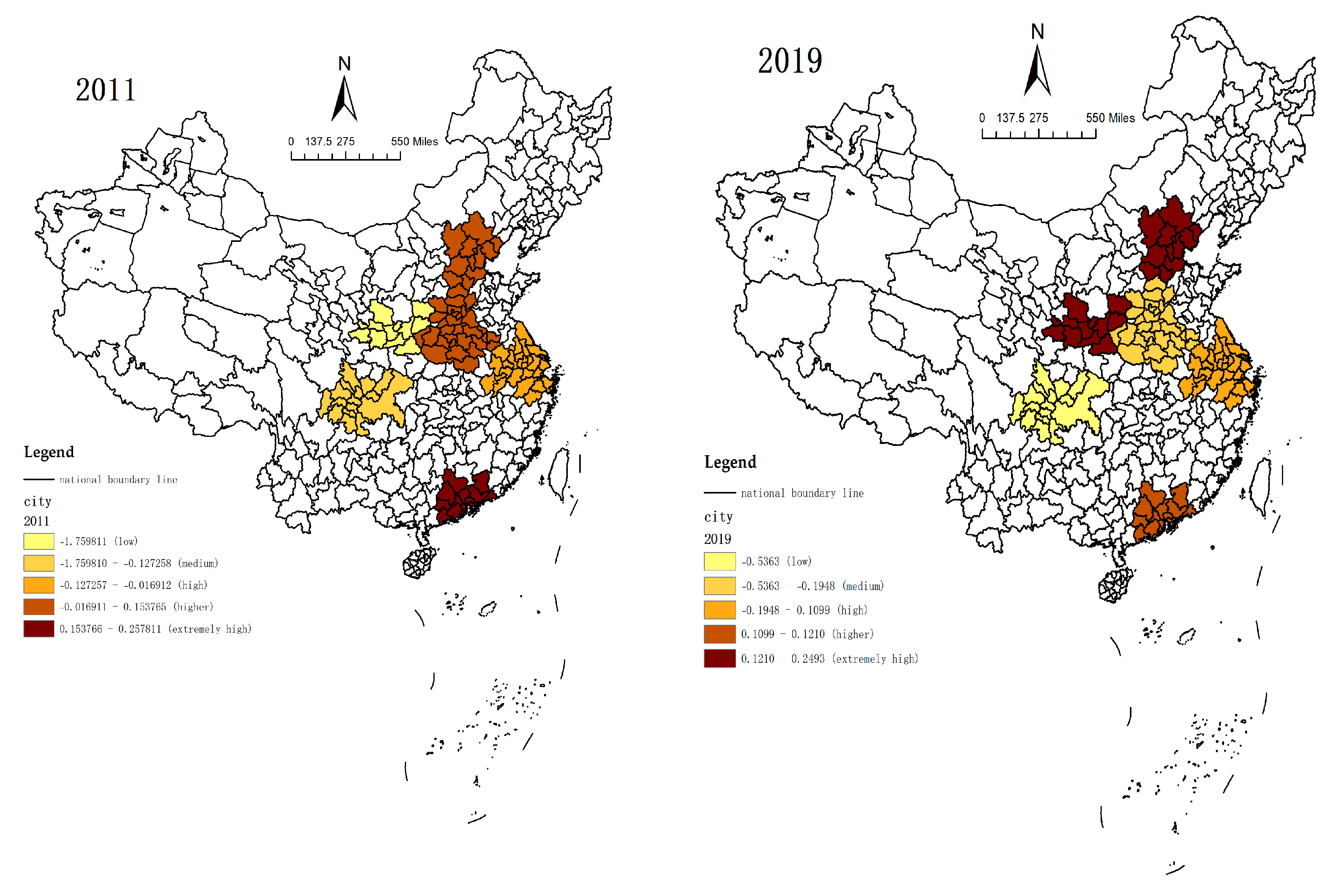
5.5. Mechanism Test
6. Conclusions and Policy Implications
- (1)
- Accelerate infrastructure construction for the digital economy and optimize the environment for its development. First, the government should support the development of digital infrastructure to consolidate the foundation of the digital economy. In particular, the government needs to increase investment in urban 5G base stations, big data, cloud computing, the Internet of things, industrial Internet, and other information technology infrastructure and platforms and build a new type of intelligent, low-carbon and green infrastructure system. Second, improve the overall level and development efficiency of the digital economy. The government should promote the construction of digital platforms at national, provincial and municipal levels. Promote the optimization and upgrading of the industrial chain, and provide impetus for the realization of industrial digitalization, digital industrialization and the digital transformation of enterprises. Accelerate data centralization and sharing among regional enterprises and promote efficient and coordinated development of the digital economy. Third, cultivate digital talents and speed up the construction of high-quality talents. The government should thoroughly implement the “Foundation Strengthening Plan” for education; establish and improve the school–enterprise cooperation system, talent introduction system, and expert service system; and focus on training talents in computer, communication, and other digital majors and interdisciplinary subjects to fill the talent gap. At the same time, it attracts and receives top high-quality talents and scientists at home and abroad to serve the development of the digital economy and create digital talent advantages.
- (2)
- Attach great importance to the transmission of regional innovation and entrepreneurship, and establish a support system for innovation and entrepreneurship that matches the development level of the digital economy. First, give full play to the innovative and creative effects of the digital economy. The government should deepen the typical demonstration role of leading enterprises in leading regions. Encourage strategic scientific and technological innovation activities in the digital economy. Establish a sound regional information network platform for innovation and entrepreneurship, and realize a development model jointly driven by “digital economy” and “innovation and entrepreneurship” to provide impetus for sustainable development. Second, attach importance to the special role of entrepreneurs. Strengthen regional industry–university–research cooperation and innovation, and encourage cross-border exchanges and collaboration. Establish and improve the talent evaluation and welfare incentive system. The government should give certain support to entrepreneurs from the aspects of finance, taxation, and financial policies to ensure that they can give full play to the spirit of innovation and entrepreneurship so as to promote the sustainable development of enterprises with a higher level and higher efficiency.
- (3)
- Implement differentiated development strategies and achieve balanced development among regions. For the development problems in the eastern, central, and western regions, the government should “take appropriate measures”. First, guide and support the central and western regions to learn from the developed eastern regions, accelerate market-oriented reform, and foster a favorable market environment. Appropriately strengthen fiscal and tax incentives, industrial policies, and financial services support for the development of the digital economy in the central and western regions. Accelerate the improvement of digital economic infrastructure, gradually narrow the gap with the eastern region, and solve the development problem of the digital divide. Second, for the eastern region, the government need to encourage and support faster breakthroughs in key digital technologies and resolve technical difficulties in “bottleneck” and strategic science and technology areas. Encourage enterprises in traditional industries to transform into intelligent and digital enterprises, and strengthen the driving role of digitalization in sustainable development. Strengthen the sense of regional cooperation and give full play to the “goose effect” of cities at the core of digital economic development in eastern China.
Author Contributions
Funding
Institutional Review Board Statement
Informed Consent Statement
Data Availability Statement
Conflicts of Interest
References
- Gao, C.; Yao, D.; Fang, J.; He, Z. Analysis of the Relationships between Financial Development and Sustainable Economic Growth: Evidence from Chinese Cities. Sustainability 2022, 14, 9348. [Google Scholar] [CrossRef]
- Vargas, C.M. Community development and micro-enterprises: Fostering sustainable development. Sustain. Dev. 2000, 8, 11–26. [Google Scholar] [CrossRef]
- Guo, J.; Liu, H.; Wu, X.; Gu, J.; Song, S.; Tang, Y. Natural Disasters, Economic Growth and Sustainable Development in China―An Empirical Study Using Provincial Panel Data. Sustainability 2015, 7, 5847. [Google Scholar] [CrossRef]
- Lee, K.-J.; Lu, S.-L. The Impact of COVID-19 on the Stock Price of Socially Responsible Enterprises: An Empirical Study in Taiwan Stock Market. Int. J. Environ. Res. Public Health 2021, 18, 1398. [Google Scholar] [CrossRef] [PubMed]
- Bai, C.; Quayson, M.; Sarkis, J. COVID-19 pandemic digitization lessons for sustainable development of micro- and small- enterprises. Sustain. Prod. Consum. 2021, 27, 1989–2001. [Google Scholar] [CrossRef] [PubMed]
- Shafi, M.; Liu, J.; Ren, W. Impact of COVID-19 pandemic on micro, small, and medium-sized Enterprises operating in Pakistan. Res. Glob. 2020, 2, 100018. [Google Scholar] [CrossRef]
- Chen, J.; Huang, J.; Su, W.; Štreimikienė, D.; Baležentis, T. The challenges of COVID-19 control policies for sustainable development of business: Evidence from service industries. Technol. Soc. 2021, 66, 101643. [Google Scholar] [CrossRef] [PubMed]
- Pan, W.; Xie, T.; Wang, Z.; Ma, L. Digital economy: An innovation driver for total factor productivity. J. Bus. Res. 2022, 139, 303–311. [Google Scholar] [CrossRef]
- Central People’s Government of the People’s Republic of China. In the 14th Five-Year Plan, the Digital Economy Moved to a New Stage of Universal Benefit and Sharing. Available online: http://www.gov.cn/zhengce/2022-01/13/content_5667955.htm (accessed on 13 January 2022).
- China Daily Chinese Website. 2022 Global Digital Economy Conference Opens in Beijing to Share Development Opportunities and Launch Digital Civilization. Available online: http://ex.chinadaily.com.cn/exchange/partners/82/rss/channel/cn/columns/80x78w/stories/WS62e8da0aa3101c3ee7ae1fb5.html (accessed on 2 August 2022).
- Ding, C.; Liu, C.; Zheng, C.; Li, F. Digital Economy, Technological Innovation and High-Quality Economic Development: Based on Spatial Effect and Mediation Effect. Sustainability 2022, 14, 216. [Google Scholar] [CrossRef]
- Lamberton, C.; Stephen, A.T. A Thematic Exploration of Digital, Social Media, and Mobile Marketing: Research Evolution from 2000 to 2015 and an Agenda for Future Inquiry. J. Mark. 2016, 80, 146–172. [Google Scholar] [CrossRef]
- Jones, P.; Wynn, M. The Leading Digital Technology Companies and Their Approach to Sustainable Development. Sustainability 2021, 13, 6612. [Google Scholar] [CrossRef]
- Xiang, X.; Yang, G.; Sun, H. The Impact of the Digital Economy on Low-Carbon, Inclusive Growth: Promoting or Restraining. Sustainability 2022, 14, 7187. [Google Scholar] [CrossRef]
- Xu, G.; Lu, T.; Liu, Y. Symmetric Reciprocal Symbiosis Mode of China’s Digital Economy and Real Economy Based on the Logistic Model. Symmetry 2021, 13, 1136. [Google Scholar] [CrossRef]
- Song, M.; Zheng, C.; Wang, J. The role of digital economy in China’s sustainable development in a post-pandemic environment. J. Enterp. Inf. Manag. 2022, 35, 58–77. [Google Scholar] [CrossRef]
- Rajnai, Z.; Kocsis, I. Labor market risks of industry 4.0, digitization, robots and AI. In Proceedings of the 2017 IEEE 15th International Symposium on Intelligent Systems and Informatics (SISY), Subotica, Serbia, 14–16 September 2017; pp. 343–346. [Google Scholar] [CrossRef]
- Deming, D.; Kahn, L.B. Skill Requirements across Firms and Labor Markets: Evidence from Job Postings for Professionals. J. Labor Econ. 2017, 36, S337–S369. [Google Scholar] [CrossRef]
- Acemoglu, D.; Restrepo, P. The Race between Man and Machine: Implications of Technology for Growth, Factor Shares, and Employment. Am. Econ. Rev. 2018, 108, 1488–1542. [Google Scholar] [CrossRef]
- Bogoviz, A.V.; Lobova, S.V.; Ragulina, J.V. Perspectives of Growth of Labor Efficiency in the Conditions of the Digital Economy; The Cham Press: Cham, Switzerland, 2019; pp. 1208–1215. [Google Scholar]
- Piroșcă, G.I.; Șerban-Oprescu, G.L.; Badea, L.; Stanef-Puică, M.-R.; Valdebenito, C.R. Digitalization and Labor Market—A Perspective within the Framework of Pandemic Crisis. J. Theor. Appl. Electron. Commer. Res. 2021, 16, 2843–2857. [Google Scholar] [CrossRef]
- Richnák, P.; Gubová, K. Green and Reverse Logistics in Conditions of Sustainable Development in Enterprises in Slovakia. Sustainability 2021, 13, 581. [Google Scholar] [CrossRef]
- Balkyte, A.; Tvaronavičiene, M. Perception of competitiveness in the context of sustainable development: Facets of “sustainable competitiveness”. J. Bus. Econ. Manag. 2010, 11, 341–365. [Google Scholar] [CrossRef]
- Cardinal, L.B. Technological Innovation in the Pharmaceutical Industry: The Use of Organizational Control in Managing Research and Development. Organ. Sci. 2001, 12, 19–36. [Google Scholar] [CrossRef]
- Su, J.; Su, K.; Wang, S. Does the Digital Economy Promote Industrial Structural Upgrading?—A Test of Mediating Effects Based on Heterogeneous Technological Innovation. Sustainability 2021, 13, 10105. [Google Scholar] [CrossRef]
- Li, Y.; Yang, X.; Ran, Q.; Wu, H.; Irfan, M.; Ahmad, M. Energy structure, digital economy, and carbon emissions: Evidence from China. Environ. Sci. Pollut. Res. 2021, 28, 64606–64629. [Google Scholar] [CrossRef]
- Dai, X. Towards a digital economy with Chinese characteristics? New Media Soc. 2002, 4, 141–162. [Google Scholar] [CrossRef]
- Guryanova, A.V.; Smotrova, I.V.; Makhovikov, A.E.; Koychubaev, A.S. Socio-Ethical Problems of the Digital Economy: Challenges and Risks; Springer International Publishing: Cham, Switzerland, 2020; pp. 96–102. [Google Scholar] [CrossRef]
- Heo, P.S.; Lee, D.H. Evolution of the linkage structure of ICT industry and its role in the economic system: The case of Korea. Inf. Technol. Dev. 2019, 25, 424–454. [Google Scholar] [CrossRef]
- Litvinenko, V.S. Digital Economy as a Factor in the Technological Development of the Mineral Sector. Nat. Resour. Res. 2020, 29, 1521–1541. [Google Scholar] [CrossRef]
- He, X.; Ping, Q.; Hu, W. Does digital technology promote the sustainable development of the marine equipment manufacturing industry in China? Mar. Policy 2022, 136, 104868. [Google Scholar] [CrossRef]
- Kudryavtseva, T.; Fesenko, R.; Kravchenko, V. Impact of the transition to a digital economy on the sustainable development of Russian regions. In Proceedings of the 2019 International SPBPU Scientific Conference on Innovations in Digital Economy, Saint Petersburg, Russian, 24–25 October 2019; Association for Computing Machinery: Saint Petersburg, Russian, 2019; p. 22. [Google Scholar] [CrossRef]
- Vorobyov, Y.; Burkaltseva, D.; Kovalyova, I.; Borsch, L.; Gerasimova, S. Sustainable Development of the Regional Economy Indicators Analysis Systematization. J. Adv. Res. Law Econ. 2018, 9, 729–739. [Google Scholar] [CrossRef]
- Yang, Q.; Ma, H.; Wang, Y.; Lin, L. Research on the influence mechanism of the digital economy on regional sustainable development. Procedia Comput. Sci. 2022, 202, 178–183. [Google Scholar] [CrossRef]
- Dyatlov, S.A.; Didenko, N.I.; Lobanov, O.S.; Kulik, S.V. Digital transformation and convergence effect as factors of achieving sustainable development. IOP Conf. Ser. Earth Environ. Sci. 2019, 302, 012102. [Google Scholar] [CrossRef]
- Whiteman, G.; Walker, B.; Perego, P. Planetary Boundaries: Ecological Foundations for Corporate Sustainability. J. Manag. Stud. 2013, 50, 307–336. [Google Scholar] [CrossRef]
- Jabłoński, M. Value Migration to the Sustainable Business Models of Digital Economy Companies on the Capital Market. Sustainability 2018, 10, 3113. [Google Scholar] [CrossRef]
- Androniceanu, A. Social Responsibility, an Essential Strategic Option for a Sustainable Development in the Field of Bio-Economy. Amfiteatru Econ. J. 2019, 21, 503–519. [Google Scholar] [CrossRef]
- Gumba, K.; Uvarova, S.; Belyaeva, S.; Vlasenko, V. Innovations as sustainable competitive advantages in the digital economy: Substantiation and forecasting. E3S Web Conf. 2021, 244, 10011. [Google Scholar] [CrossRef]
- Yang, X.; Jia, Y.; Wang, Q.; Li, C.; Zhang, S. Space–time evolution of the ecological security of regional urban tourism: The case of Hubei Province, China. Environ. Monit. Assess. 2021, 193, 566. [Google Scholar] [CrossRef] [PubMed]
- Chen, Z.; Wei, Y.; Shi, K.; Zhao, Z.; Wang, C.; Wu, B.; Qiu, B.; Yu, B. The potential of nighttime light remote sensing data to evaluate the development of digital economy: A case study of China at the city level. Comput. Environ. Urban Syst. 2022, 92, 101749. [Google Scholar] [CrossRef]
- Zhang, W.; Zhao, S.; Wan, X.; Yao, Y. Study on the effect of digital economy on high-quality economic development in China. PLoS ONE 2021, 16, e0257365. [Google Scholar] [CrossRef] [PubMed]
- Chindasombatcharoen, P.; Chatjuthamard, P.; Jiraporn, P.; Treepongkaruna, S. Achieving sustainable development goals through board size and innovation. Sustain. Dev. 2022, 30, 664–677. [Google Scholar] [CrossRef]
- Boons, F.; Montalvo, C.; Quist, J.; Wagner, M. Sustainable innovation, business models and economic performance: An overview. J. Clean. Prod. 2013, 45, 1–8. [Google Scholar] [CrossRef]
- Brandão Santana, N.; Rebelatto, D.A.D.N.; Périco, A.E.; Moralles, H.F.; Leal Filho, W. Technological innovation for sustainable development: An analysis of different types of impacts for countries in the BRICS and G7 groups. Int. J. Sustain. Dev. World Ecol. 2015, 22, 425–436. [Google Scholar] [CrossRef]
- Melander, L. Achieving Sustainable Development by Collaborating in Green Product Innovation. Bus. Strategy Environ. 2017, 26, 1095–1109. [Google Scholar] [CrossRef]
- Curran, D. Risk, innovation, and democracy in the digital economy. Eur. J. Soc. Theory 2017, 21, 207–226. [Google Scholar] [CrossRef]
- Carlsson, B. The Digital Economy: What is new and what is not? Struct. Chang. Econ. Dyn. 2004, 15, 245–264. [Google Scholar] [CrossRef]
- Jin, X.; Wah, B.W.; Cheng, X.; Wang, Y. Significance and Challenges of Big Data Research. Big Data Res. 2015, 2, 59–64. [Google Scholar] [CrossRef]
- Wu, H.X.; Yu, C. The impact of the digital economy on China’s economic growth and productivity performance. China Econ. J. 2022, 15, 153–170. [Google Scholar] [CrossRef]
- Jun, W.; Nasir, M.H.; Yousaf, Z.; Khattak, A.; Yasir, M.; Javed, A.; Shirazi, S.H. Innovation performance in digital economy: Does digital platform capability, improvisation capability and organizational readiness really matter? Eur. J. Innov. Manag. 2021. ahead-of-print. [Google Scholar] [CrossRef]
- Şener, S.; Sarıdoğan, E. The Effects of Science-Technology-Innovation on Competitiveness and Economic Growth. Procedia-Soc. Behav. Sci. 2011, 24, 815–828. [Google Scholar] [CrossRef]
- You, J.; Zhang, W. How heterogeneous technological progress promotes industrial structure upgrading and industrial carbon efficiency? Evidence from China’s industries. Energy 2022, 247, 123386. [Google Scholar] [CrossRef]
- Mishra, S. Financial management and forecasting using business intelligence and big data analytic tools. Int. J. Financ. Eng. 2018, 5, 1850011. [Google Scholar] [CrossRef]
- Mishra, S.; Triptahi, A.R. Platforms oriented business and data analytics in digital ecosystem. Int. J. Financ. Eng. 2019, 6, 1950036. [Google Scholar] [CrossRef]
- Mishra, S.; Tripathi, A.R. Platform business model on state-of-the-art business learning use case. Int. J. Financ. Eng. 2020, 7, 2050015. [Google Scholar] [CrossRef]
- Berg, H.; Wilts, H. Digital platforms as market places for the circular economy—requirements and challenges. Nachhalt. Sustain. Manag. Forum 2019, 27, 1–9. [Google Scholar] [CrossRef]
- Du, X.; Jiao, J.; Tseng, M.M. Understanding customer satisfaction in product customization. Int. J. Adv. Manuf. Technol. 2006, 31, 396–406. [Google Scholar] [CrossRef]
- Palma, M.A.; Collart, A.J.; Chammoun, C.J. Information Asymmetry in Consumer Perceptions of Quality-Differentiated Food Products. J. Consum. Aff. 2015, 49, 596–612. [Google Scholar] [CrossRef]
- Mueller, M.; Grindal, K. Data flows and the digital economy: Information as a mobile factor of production. Digit. Policy Regul. Gov. 2019, 21, 71–87. [Google Scholar] [CrossRef]
- Hanna, N. A role for the state in the digital age. J. Innov. Entrep. 2018, 7, 5. [Google Scholar] [CrossRef]
- Richter, C.; Kraus, S.; Brem, A.; Durst, S.; Giselbrecht, C. Digital entrepreneurship: Innovative business models for the sharing economy. Creat. Innov. Manag. 2017, 26, 300–310. [Google Scholar] [CrossRef]
- Jiang, Y. Prediction model of the impact of innovation and entrepreneurship on China’s digital economy based on neural network integration systems. Neural Comput. Appl. 2022, 34, 2661–2675. [Google Scholar] [CrossRef]
- Cooke, P. The new wave of regional innovation networks: Analysis, characteristics and strategy. Small Bus. Econ. 1996, 8, 159–171. [Google Scholar] [CrossRef]
- Yin, Z.; Gong, X.; Guo, P.; Wu, T. What Drives Entrepreneurship in Digital Economy? Evidence from China. Econ. Model. 2019, 82, 66–73. [Google Scholar] [CrossRef]
- Thomas, A.; Passaro, R.; Quinto, I. Developing Entrepreneurship in Digital Economy: The Ecosystem Strategy for Startups Growth. In Strategy and Behaviors in the Digital Economy; IntechOpen: London, UK, 2019. [Google Scholar] [CrossRef]
- Firebaugh, G.; Warner, C.; Massoglia, M. Fixed Effects, Random Effects, and Hybrid Models for Causal Analysis. In Handbook of Causal Analysis for Social Research; Morgan, S.L., Ed.; Springer: Dordrecht, The Netherlands, 2013; pp. 113–132. [Google Scholar] [CrossRef]
- Greene, W. Estimating Econometric Models with Fixed Effects; New York University, Leonard N. Stern School of Business: New York, NY, USA, 2001; Available online: https://EconPapers.repec.org/RePEc:fth:nystfi:01-10 (accessed on 30 November 2010).
- Hsiao, C. Analysis of Panel Data; Cambridge University Press: Cambridge, UK, 2003; p. 382. [Google Scholar] [CrossRef]
- Wooldridge, J.M. Basic Asymptotic Theory. In Econometric Analysis of Cross Section and Panel Data; The MIT Press: Cambridge, MA, USA, 2010; pp. 37–50. Available online: https://www.jstor.org/stable/j.ctt5hhcfr (accessed on 30 November 2010).
- Allison, P.D. Fixed-Effects Partial Likelihood for Repeated Events. Sociol. Methods Res. 1996, 25, 207–222. [Google Scholar] [CrossRef]
- Firebaugh, G. Seven Rules for Social Research; Princeton University Press: Princeton, NJ, USA, 2018. [Google Scholar] [CrossRef]
- Zhang, C. Clans, entrepreneurship, and development of the private sector in China. J. Comp. Econ. 2020, 48, 100–123. [Google Scholar] [CrossRef]
- Colino, A.; Benito-Osorio, D.; Rueda-Armengot, C. Entrepreneurship culture, total factor productivity growth and technical progress: Patterns of convergence towards the technological frontier. Technol. Forecast. Soc. Chang. 2014, 88, 349–359. [Google Scholar] [CrossRef]
- Yang, H.; Yuan, T.; Zhang, X.; Li, S. A Decade Trend of Total Factor Productivity of Key State-Owned Forestry Enterprises in China. Forests 2016, 7, 97. [Google Scholar] [CrossRef]
- Blundell, R.; Bond, S. Initial conditions and moment restrictions in dynamic panel data models. J. Econom. 1998, 87, 115–143. [Google Scholar] [CrossRef]
- Caves, D.W.; Christensen, L.R.; Diewert, W.E. The Economic Theory of Index Numbers and the Measurement of Input, Output, and Productivity. Econometrica 1982, 50, 1393–1414. [Google Scholar] [CrossRef]
- Levinsohn, J.; Petrin, A. Estimating Production Functions Using Inputs to Control for Unobservables. Rev. Econ. Stud. 2003, 70, 317–341. [Google Scholar] [CrossRef]
- Olley, G.S.; Pakes, A. The Dynamics of Productivity in the Telecommunications Equipment Industry. Econometrica 1996, 64, 1263–1297. [Google Scholar] [CrossRef]
- Rovigatti, G.; Mollisi, V. Theory and Practice of Total-Factor Productivity Estimation: The Control Function Approach using Stata. Stata. J. 2018, 18, 618–662. [Google Scholar] [CrossRef]
- Peng, J.; Xie, R.; Ma, C.; Fu, Y. Market-based environmental regulation and total factor productivity: Evidence from Chinese enterprises. Econ. Model. 2021, 95, 394–407. [Google Scholar] [CrossRef]
- Xiaobo, Z. China Innovation and Entrepreneurship Index, 4th ed.; Peking University Open Research Data Platform: Beijing, China, 2019. [Google Scholar] [CrossRef]
- Research Center for Internet Development and Governance. Economic Daily: The Digital Transformation of China’s Economy: Talent and Employment Report Released. Available online: http://cidg.sem.tsinghua.edu.cn/search/searchdilt.html?id=149 (accessed on 23 November 2017).
- Cornett, A.P. Aims and strategies in regional innovation and growth policy: A Danish perspective. Entrep. Reg. Dev. 2009, 21, 399–420. [Google Scholar] [CrossRef]
- Doloreux, D. Understanding Regional Innovation in the Maritime Industry: An Empirical Analysis. Int. J. Innov. Technol. Manag. 2006, 3, 189–207. [Google Scholar] [CrossRef]
- Cooke, P.; Gomez Uranga, M.; Etxebarria, G. Regional innovation systems: Institutional and organisational dimensions. Res. Policy 1997, 26, 475–491. [Google Scholar] [CrossRef]
- Chang, Y.-C.; Chen, M.-H.; Lin, Y.-P.; Gao, Y.-S. Measuring Regional Innovation and Entrepreneurship Capabilities. J. Knowl. Econ. 2012, 3, 90–108. [Google Scholar] [CrossRef]
- Cooke, P. To Construct Regional Advantage from Innovation Systems First Build Policy Platforms. Eur. Plan. Stud. 2007, 15, 179–194. [Google Scholar] [CrossRef]
- Audretsch, D.B.; Keilbach, M. Entrepreneurship capital and regional growth. Ann. Reg. Sci. 2005, 39, 457–469. [Google Scholar] [CrossRef]
- Porter, M. Competitive Advantage of Nations. Compet. Intell. Rev. 1990, 1, 14. [Google Scholar] [CrossRef]

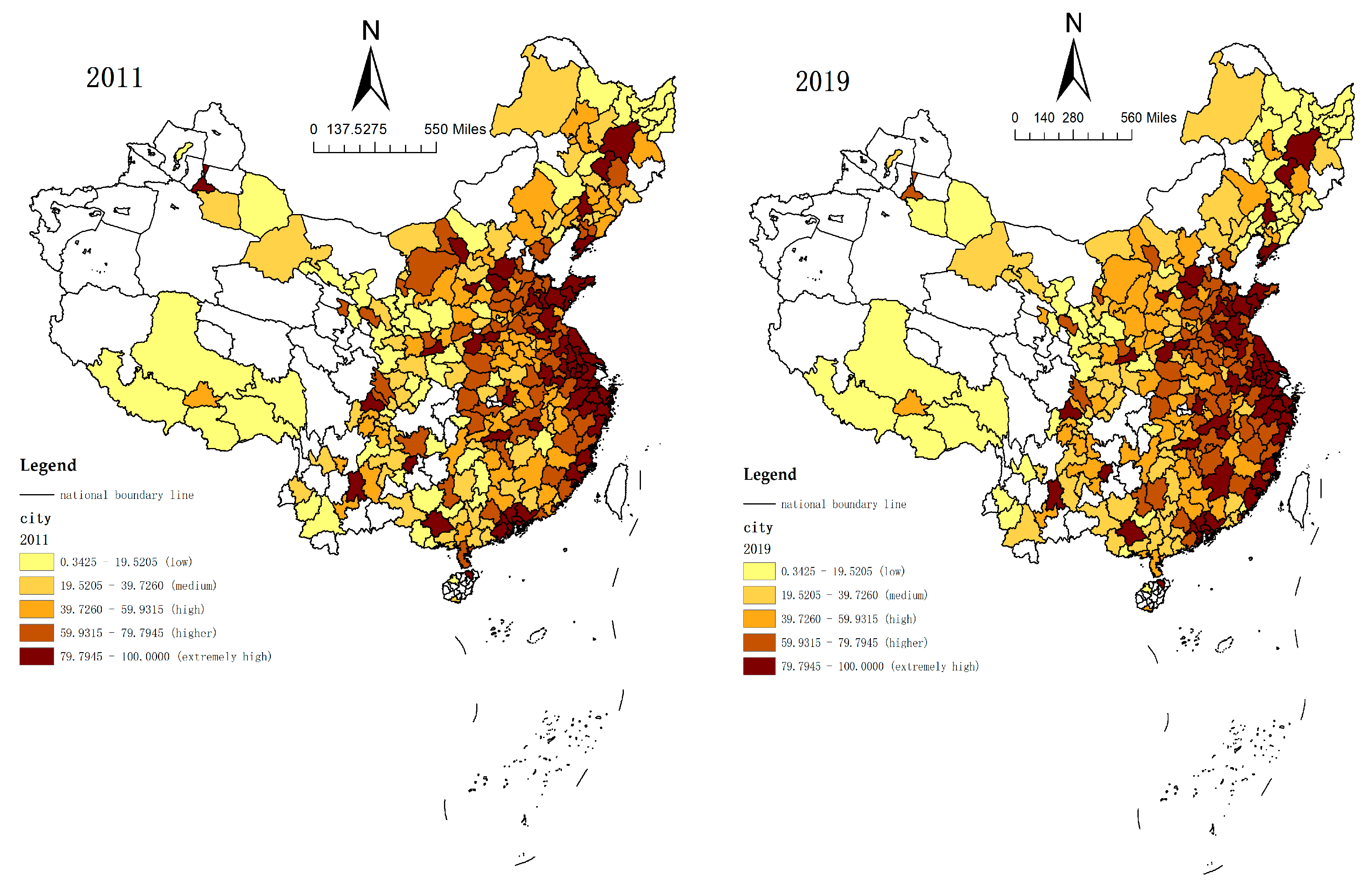
| First Indicators | The Secondary Indicators | Measured Data |
|---|---|---|
| Urban Digital Economy Index | Internet penetration rate | Internet broadband access users/ten thousand |
| Number of Internet-related employees | Number of people employed in information transmission, computer services, and software | |
| Internet-related output | Telecom service income/ten thousand yuan | |
| Number of mobile Internet users | Number of mobile phone users/10,000 people | |
| Inclusive development of digital finance | China Digital Financial Inclusion Index |
| Variable Types | The Variable Name | Variable Symbol | Calculation |
|---|---|---|---|
| Explained variable | Sustainable development | sde | See Equation (3). |
| Core explanatory variable | Urban Digital Economy Index | digital | Calculated by the model above |
| Mechanism of variable | Regional Innovation and Entrepreneurship Index | ie | |
| Control variables | The enterprise scale | size | Ln (number of employees) |
| Enterprise age | age | Ln (Current year—year of listing) | |
| Return on total assets | roa | Mean of net profit/total assets at the beginning and end of the period | |
| Government subsidies | gov | Ln (government subsidy) | |
| Financial leverage | lev | Total liabilities/total assets | |
| Board size | board | Ln (1 + board size) | |
| Concentration of ownership | ocon | Ln (1 + Shareholding ratio of the largest shareholder) | |
| Urban population size | popu | Ln (total urban population) | |
| The scale of urban economic development | GDP | Ln (GDP) |
| Variables | N | Mean | Str | Min | Max |
|---|---|---|---|---|---|
| sde | 22,326 | 8.129 | 1.039 | 4.919 | 12.367 |
| digital | 19,532 | 10.302 | 1.313 | 5.995 | 12.803 |
| ie | 15,514 | 82.734 | 21.396 | 0.685 | 100 |
| size | 22,319 | 7.657 | 1.291 | 1.946 | 13.223 |
| age | 22,326 | 1.961 | 0.932 | 0 | 3.367 |
| lev | 22,326 | 0.430 | 0.215 | 0.007 | 3.919 |
| roa | 22,325 | 0.037 | 0.079 | −1.872 | 0.675 |
| board | 17,088 | 2.243 | 0.179 | 0 | 2.944 |
| ocon | 22,326 | 3.472 | 0.456 | 0.255 | 4.511 |
| gov | 21,581 | 16.080 | 1.847 | 5.218 | 23.150 |
| GDP | 19,606 | 8.867 | 1.107 | 4.117 | 10.550 |
| popu | 19,470 | 6.428 | 0.693 | 2.944 | 8.136 |
| Benchmark Regression | Test for Robustness | ||||
|---|---|---|---|---|---|
| (1) | (2) | (3) | (4) | (5) | |
| digital | 0.010 *** (9.43) | 0.010 *** (5.61) | 1.95 × 10−7 ** (2.00) | 1.84 × 10−7 * (1.88) | |
| mdigital | 0.010 *** (5.62) | ||||
| control variable | NO | YES | YES | YES | YES |
| Year FE | YES | YES | YES | YES | YES |
| Ind Fe | YES | YES | YES | YES | YES |
| Year × Ind | YES | ||||
| Observations | 19,532 | 14,217 | 14,217 | 14,217 | 14,211 |
| (6) | (7) | (8) | ||
|---|---|---|---|---|
| Diff-GMM | Sys-GMM | First Stage | Second Stage | |
| L.lnsde | 0.579 *** (11.15) | 0.722 *** (22.59) | ||
| digital | 0.160 *** (3.49) | 0.155 *** (3.93) | 0.157 *** (5.03) | |
| bjdis | −0.094 *** (−64.74) | |||
| control variable | YES | YES | YES | YES |
| Year FE | YES | YES | YES | YES |
| Ind Fe | YES | YES | ||
| Sargan test | Not over recognized | Not over recognized | ||
| Observations | 9654 | 12,003 | 14,217 | 14,217 |
| Mechanism Inspection | |
|---|---|
| ie | 0.019 *** (3.26) |
| control variable | YES |
| Year FE | YES |
| Ind Fe | YES |
| Observations | 10,977 |
Publisher’s Note: MDPI stays neutral with regard to jurisdictional claims in published maps and institutional affiliations. |
© 2022 by the authors. Licensee MDPI, Basel, Switzerland. This article is an open access article distributed under the terms and conditions of the Creative Commons Attribution (CC BY) license (https://creativecommons.org/licenses/by/4.0/).
Share and Cite
Zhou, Z.; Liu, W.; Cheng, P.; Li, Z. The Impact of the Digital Economy on Enterprise Sustainable Development and Its Spatial-Temporal Evolution: An Empirical Analysis Based on Urban Panel Data in China. Sustainability 2022, 14, 11948. https://doi.org/10.3390/su141911948
Zhou Z, Liu W, Cheng P, Li Z. The Impact of the Digital Economy on Enterprise Sustainable Development and Its Spatial-Temporal Evolution: An Empirical Analysis Based on Urban Panel Data in China. Sustainability. 2022; 14(19):11948. https://doi.org/10.3390/su141911948
Chicago/Turabian StyleZhou, Zhiqiang, Wenyan Liu, Pengfei Cheng, and Zhenjin Li. 2022. "The Impact of the Digital Economy on Enterprise Sustainable Development and Its Spatial-Temporal Evolution: An Empirical Analysis Based on Urban Panel Data in China" Sustainability 14, no. 19: 11948. https://doi.org/10.3390/su141911948
APA StyleZhou, Z., Liu, W., Cheng, P., & Li, Z. (2022). The Impact of the Digital Economy on Enterprise Sustainable Development and Its Spatial-Temporal Evolution: An Empirical Analysis Based on Urban Panel Data in China. Sustainability, 14(19), 11948. https://doi.org/10.3390/su141911948






